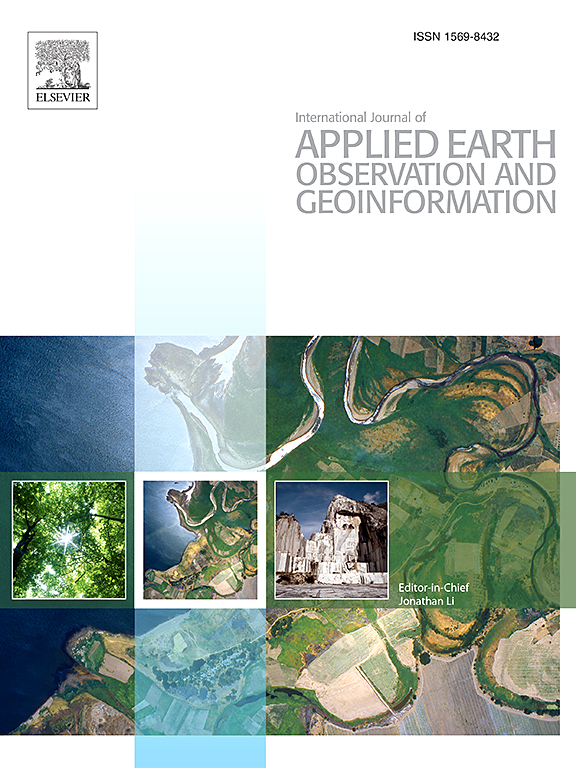通过非常高分辨率的无人机基准和ConvFlow变压器进行大规模烟草识别
IF 7.6
Q1 REMOTE SENSING
International journal of applied earth observation and geoinformation : ITC journal
Pub Date : 2025-05-01
DOI:10.1016/j.jag.2025.104549
引用次数: 0
摘要
遥感和人工智能技术推动了精准农业和智慧农业的发展。其中,烟草作为一种重要的经济作物,其研究很少,其大规模鉴定任务一直遇到一些挑战。首先,烟草经常与其他作物间作,如玉米。这些作物有相似的颜色和质地,只有种植间距和排列上的细微差别。这些细微的差异在遥感图像中变得更加难以观察到。其次,烟草的生长是一个连续的、不断进化的过程,在不同的生长阶段和季节,烟草的特征会有很大的不同,这使得鉴定工作更加复杂。此外,据我们所知,公众无法获得烟草数据集,这阻碍了具有最佳性能的深度学习(DL)模型的发展。因此,本文开展了全球首个总容量为67GB的大型无人机遥感烟草数据集(LUSET)。LUSET中10幅大尺度图像被精确标注,平均分辨率约为20000 × 20000像素,可划分为7252 512 × 512个样本1。然后,针对烟草在不同作物间具有丰富的多样性和高的类间相似性,提出了一种双支路的ConvFlow变压器。提出了一种基于无位置设计的卷积特征增强多头自注意(CF-MHSA)算法,将标准注意中的值矩阵替换为卷积多尺度特征,有效地实现了卷积分支与变压器分支的特征交互与融合。精细特征的融合使我们能够更好地区分不同作物的纹理特征,代表不同生长周期的形态特征。这解决了烟草识别方面的两大挑战。在无人机烟叶数据上的大量实验证明,ConvFlow Transformer的策略可以很容易地在主流变压器中实现,并且以较少的计算量显著提高了主流变压器在烟叶识别方面的性能。本文章由计算机程序翻译,如有差异,请以英文原文为准。
Large-scale tobacco identification via a very-high-resolution unmanned aerial vehicle benchmark and a ConvFlow Transformer
Remote sensing and artificial intelligence technology have propelled the development of precision agriculture and smart agriculture. Among them, as a crucial economic crop, tobacco has been rarely studied and its large-scale identification task has consistently encountered several challenges. Firstly, tobacco is often inter-cropped with other crops, such as corn. These crops have similar colors and textures, with only minor differences in planting spacing and arrangement. These slight differences become even less observable in remote sensing imagery. Secondly, tobacco growth is a continuous and evolving process, resulting in drastically different characteristics during various growth stages and seasons, which further complicates the task of identification. Moreover, to the best of our knowledge, no tobacco dataset is accessible to the public, impeding the development of a deep learning (DL) model with optimal performance. Therefore, a Large-scale UAV remote SEnsing Tobacco dataset (LUSET) which is the world’s first tobacco dataset with a total volume of 67GB has been conducted in this paper. 10 large-scale images in the LUSET are accurately annotated with an average resolution of about 20,000 × 20,000 pixels, which can be divided into 7,252 512 × 512 samples1. Then, a dual-branch ConvFlow Transformer is proposed to address tobacco’s rich diversity and high inter-class similarity among different crops. A novel Convolutional Feature-enhanced Multi-Head Self-attention (CF-MHSA) with a location-free design in the ConvFlow Transformer is developed to replace the value matrix in the standard attention with the convolutional multi-scale features, which effectively achieves feature interaction and fusion from the convolutional and transformer branches. The fusion of refined features allows us to better distinguish the texture characteristics of different crops and represent their morphological features during different growth cycles. This addresses the two major challenges in tobacco recognition. Extensive experiments on the UAV tobacco data proved that the strategy of ConvFlow Transformer can be easily achieved in the mainstream Transformers and significantly improve their performance in tobacco identification with a small amount of computation.
求助全文
通过发布文献求助,成功后即可免费获取论文全文。
去求助
来源期刊

International journal of applied earth observation and geoinformation : ITC journal
Global and Planetary Change, Management, Monitoring, Policy and Law, Earth-Surface Processes, Computers in Earth Sciences
CiteScore
12.00
自引率
0.00%
发文量
0
审稿时长
77 days
期刊介绍:
The International Journal of Applied Earth Observation and Geoinformation publishes original papers that utilize earth observation data for natural resource and environmental inventory and management. These data primarily originate from remote sensing platforms, including satellites and aircraft, supplemented by surface and subsurface measurements. Addressing natural resources such as forests, agricultural land, soils, and water, as well as environmental concerns like biodiversity, land degradation, and hazards, the journal explores conceptual and data-driven approaches. It covers geoinformation themes like capturing, databasing, visualization, interpretation, data quality, and spatial uncertainty.
 求助内容:
求助内容: 应助结果提醒方式:
应助结果提醒方式:


